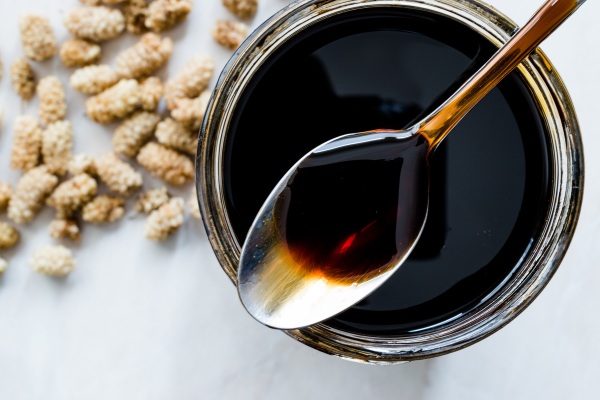A Sweet History
Molasses, also known as ‘black gold’ or ‘the nectar of the earth,’ is a thick, dark syrup made during the sugar refining process. Its history goes back centuries to ancient civilizations, who cherished its sweetness and many uses. The term ‘molasses’ comes from the Portuguese word ‘melaco,’ meaning honey-like.
Types of Molasses
Light, also called ‘Barbados’ or ‘sweet’ molasses, comes from the first boiling of sugar cane juice. It offers a sweet flavor and is commonly used in baking and marinades.
Moving to the darker type:
Dark, resulting from the second boiling of sugar cane juice, is thicker and has a stronger flavor than light molasses. It’s popularly used in gingerbread, cookies, and some barbecue sauces.
Now onto the darkest and thickest variety:
Blackstrap, produced after the third boiling of sugar cane juice, is the darkest and thickest kind, with a slightly bitter taste. Rich in nutrients, it’s frequently utilized in recipes needing a bold, deep flavor, like specific bread, cookies, and meat dishes.
Culinary Applications:
Starting with baking:
This ingredient plays a common role in sweetening baked goods like gingerbread cookies, muffins, and cakes, infusing them with a distinct depth and richness.
Moving on to marinades and sauces:
In marinades and sauces, it offers a sweet, slightly tangy profile that works wonders, particularly in marinades for meats and poultry. It’s also a staple base for barbecue sauces, imparting a smoky sweetness to grilled dishes.
Transitioning to glazes:
When used in glazes, molasses can elevate ordinary dishes to culinary delights. It’s often brushed onto roasted vegetables, ham, and salmon, creating a delightful caramelized finish.
Concluding with beverages:
In beverages, molasses serves as both a sweetener and a flavor enhancer, adding its unique touch to drinks like hot toddies, cocktails, and traditional health topics such as ‘blackstrap molasses water’.
Sourcing Considerations
Grade and Type:
To suit your product needs, consider the different flavors and colors imparted by light, dark, or blackstrap molasses to your final product.
Origin:
Molasses sourced from various regions worldwide carries distinct flavors influenced by the soil and climate where the sugar cane grows. Choose the origin based on the flavor profile you desire.
Processing Method:
Some molasses undergoes sulfuring, treated with sulfur dioxide to preserve color and shelf life. Opt for unsulfured molasses if you prefer a purer, chemical-free product.
Organic and Non-GMO:
For products emphasizing organic or non-GMO ingredients, ensure your molasses aligns with these principles.
Packaging:
Explore packaging options such as bulk quantities in drums or smaller containers like jars or bottles, selecting based on your production needs.
Exploring Molasses in Culinary Creations
Molasses has been an enduring ingredient in the culinary world for centuries. For food ingredient purchasers, grasping the different types, culinary uses, and sourcing factors is crucial, particularly when integrating this flavorful ingredient into your product lineup effectively.
Whether you’re concocting indulgent desserts, savory marinades, or wholesome baked goods, molasses shines as a star ingredient. Its addition brings depth, sweetness, and character to your creations. Embrace its sweet history and diverse flavors to witness its transformative effect on your food products, leaving a lasting impression on your customers’ taste buds.


